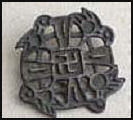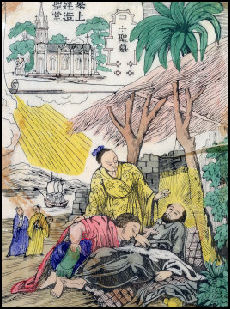CHRISTIANITY IN CHINA

8th century cross in China
 The Chinese were exposed to Christianity and Islam during the A.D. 7th
and 8th century, but ultimately they found both beliefs unappealing as
they did with Zoroastrianism and Manicheanism— the belief that good and
evil exists in all humans, and that life is a struggle between the
spirit and the flesh. All these faiths arrived in China on Silk Road
The Chinese were exposed to Christianity and Islam during the A.D. 7th
and 8th century, but ultimately they found both beliefs unappealing as
they did with Zoroastrianism and Manicheanism— the belief that good and
evil exists in all humans, and that life is a struggle between the
spirit and the flesh. All these faiths arrived in China on Silk Road  Emperors during the T'ang dynasty (618-907) for the most part tolerated
members all sorts of religious sects—Taoist and Confucian scholars,
Christian missionaries, Zoroastrian priests, and Buddhist monks. On his
trip to China in the 13th century Marco Polo wrote: "The people are for
the most part idolaters, but there are also some Nestorian Christians
and Saracens [Muslims]."
Emperors during the T'ang dynasty (618-907) for the most part tolerated
members all sorts of religious sects—Taoist and Confucian scholars,
Christian missionaries, Zoroastrian priests, and Buddhist monks. On his
trip to China in the 13th century Marco Polo wrote: "The people are for
the most part idolaters, but there are also some Nestorian Christians
and Saracens [Muslims]."  A
survey by East China Normal University counted 40 million Christians
A
survey by East China Normal University counted 40 million Christians
.
There is evidence that the number is much larger and growing. The
numbers are particularly high among the young. China has the potential
to be the world’s largest Christian nation.
 Proselytizing Christianity is banned under Chinese law. Even so there
are large numbers of missionaries in Xinjiang and other places, many
working as English teachers, and authorities often turn a blind eye to
their activities. In his book The Tree That Bleeds: a Uyghur Town on the Edge
Nick Holdstock wrote authorities at the university where he worked
made it clear that, unlike usually when a crime is committed in China,
they would not act without hard evidence.
Proselytizing Christianity is banned under Chinese law. Even so there
are large numbers of missionaries in Xinjiang and other places, many
working as English teachers, and authorities often turn a blind eye to
their activities. In his book The Tree That Bleeds: a Uyghur Town on the Edge
Nick Holdstock wrote authorities at the university where he worked
made it clear that, unlike usually when a crime is committed in China,
they would not act without hard evidence.  Good Websites and Sources: Church in China churchinchina.com ;Christianity in China christianityinchina.org ; Wikipedia article Wikipedia ; History of Christianity in China Ricci Roundtable ; U.S. Catholic China Bureau usccb.net ; Christain of China christianofchina.com ; CHINESE CATHOLICS Factsanddetails.com/China ;
Good Websites and Sources: Church in China churchinchina.com ;Christianity in China christianityinchina.org ; Wikipedia article Wikipedia ; History of Christianity in China Ricci Roundtable ; U.S. Catholic China Bureau usccb.net ; Christain of China christianofchina.com ; CHINESE CATHOLICS Factsanddetails.com/China ;  Links in this Website to Different Religions in China: RELIGION IN CHINA Factsanddetails.com/China ; FOLK RELIGION IN CHINA Factsanddetails.com/China ; CONFUCIANISM AND CONFUCIUS Factsanddetails.com/China ; CONFUCIAN BELIEFS Factsanddetails.com/China ; TAOISM Factsanddetails.com/China ; TAOIST BELIEFS Factsanddetails.com/China ; BUDDHISM IN CHINA Factsanddetails.com/China ;HISTORY OF BUDDHISM IN CHINA Factsanddetails.com/China ; HISTORY OF TIBETAN BUDDHISM Factsanddetails.com/China ; TIBETAN BUDDHISM BELIEFS Factsanddetails.com/China ; MUSLIMS AND JEWS IN CHINA Factsanddetails.com/China ; MYSTICISM AND SUPERSTITION IN CHINA Factsanddetails.com/China ; FENG SHUI AND QI QONG Factsanddetails.com/China ; IDEAS ABOUT DEATH IN CHINA Factsanddetails.com/China
Links in this Website to Different Religions in China: RELIGION IN CHINA Factsanddetails.com/China ; FOLK RELIGION IN CHINA Factsanddetails.com/China ; CONFUCIANISM AND CONFUCIUS Factsanddetails.com/China ; CONFUCIAN BELIEFS Factsanddetails.com/China ; TAOISM Factsanddetails.com/China ; TAOIST BELIEFS Factsanddetails.com/China ; BUDDHISM IN CHINA Factsanddetails.com/China ;HISTORY OF BUDDHISM IN CHINA Factsanddetails.com/China ; HISTORY OF TIBETAN BUDDHISM Factsanddetails.com/China ; TIBETAN BUDDHISM BELIEFS Factsanddetails.com/China ; MUSLIMS AND JEWS IN CHINA Factsanddetails.com/China ; MYSTICISM AND SUPERSTITION IN CHINA Factsanddetails.com/China ; FENG SHUI AND QI QONG Factsanddetails.com/China ; IDEAS ABOUT DEATH IN CHINA Factsanddetails.com/China
Early Christians in China
 Nestorian Christians (a sect originally from Syria) arrived in China on
the Silk Road in the A.D. 7th century. According to the Nestorian
Stone, a 10-meter-high tablet discovered in the 17th century and dated
to A.D. 781, Nestorian missionaries, led by one Bishop Alopen, arrived
from present-day Afghanistan in A.D. 635.
Nestorian Christians (a sect originally from Syria) arrived in China on
the Silk Road in the A.D. 7th century. According to the Nestorian
Stone, a 10-meter-high tablet discovered in the 17th century and dated
to A.D. 781, Nestorian missionaries, led by one Bishop Alopen, arrived
from present-day Afghanistan in A.D. 635.
 Nestorian Christianity is largely extinct but at one time it was quite a
powerful Christian sect and was at the center of important doctrinal
controversies. The Nestorians emphasized the duality of being between
man and divine. They were regarded as heretics by other sects for their
belief that there were two separate persons in the incarnate Christ,
denying that Christ was in one person both God and man. They went on to
argue that Mary was either the mother of God (a blasphemous concept to
many Christians) or the mother of the man Jesus; but she couldn't have
it both ways.
Nestorian Christianity is largely extinct but at one time it was quite a
powerful Christian sect and was at the center of important doctrinal
controversies. The Nestorians emphasized the duality of being between
man and divine. They were regarded as heretics by other sects for their
belief that there were two separate persons in the incarnate Christ,
denying that Christ was in one person both God and man. They went on to
argue that Mary was either the mother of God (a blasphemous concept to
many Christians) or the mother of the man Jesus; but she couldn't have
it both ways.

 The first Nestorian church in China was founded in 638 in Changsan
(Xian) by a Syrian named Raban. Nestorian Christians translated the
Bible into Chinese. Their religion was officially tolerated by the Tang
dynasty emperors for over 200 years until they were suddenly ordered to
return home in 845.
The first Nestorian church in China was founded in 638 in Changsan
(Xian) by a Syrian named Raban. Nestorian Christians translated the
Bible into Chinese. Their religion was officially tolerated by the Tang
dynasty emperors for over 200 years until they were suddenly ordered to
return home in 845.  An altar with a nativity scene and an image of the Virgin Mary was
discovered in the late 1990s in an ancient pagoda, dated to A.D. 638, in
Lou Guan Tai, a two hour drive south of Xian. The pagoda was oriented
toward the east like a church rather than north and south like a Chinese
temple, which is seen as evidence that it was a church before it became
a pagoda. The discovery was viewed as an indication that the Nestorians
were not a fringe movement but rather one that penetrated deep into
China.
An altar with a nativity scene and an image of the Virgin Mary was
discovered in the late 1990s in an ancient pagoda, dated to A.D. 638, in
Lou Guan Tai, a two hour drive south of Xian. The pagoda was oriented
toward the east like a church rather than north and south like a Chinese
temple, which is seen as evidence that it was a church before it became
a pagoda. The discovery was viewed as an indication that the Nestorians
were not a fringe movement but rather one that penetrated deep into
China.
Archaeologists have also discovered passages from the Psalms
written in the Nestorian’s Syriac language in Mogao Caves in Dunhuang,
which showed that Christianity spread as far north as Mongolia.
 Marco Polo wrote there were some 700,000 Christian in China when he
visited in the 13th century. Describing an encounter with some he
wrote: his father and uncle "enquired from what source they had received
their faith and their rule, and their informants replied: 'From our
forefathers.' It came out that they had in a certain temple three
pictures representing three apostles...who had instructed their
ancestors on the faith long ago, and it had been persevered among them
for 700 years." These Christians were most likely Nestorians.
Marco Polo wrote there were some 700,000 Christian in China when he
visited in the 13th century. Describing an encounter with some he
wrote: his father and uncle "enquired from what source they had received
their faith and their rule, and their informants replied: 'From our
forefathers.' It came out that they had in a certain temple three
pictures representing three apostles...who had instructed their
ancestors on the faith long ago, and it had been persevered among them
for 700 years." These Christians were most likely Nestorians.
Christians in the Chinese Imperial and Colonial Period

St. Xavier dying in China
 Jesuit missionaries were among the first foreigners to arrive in China.
At first they were not allowed to preach but their advise was sought on
scientific and astronomical matters Their knowledge about astronomy was
particularly valued because the Emperor need knowledge about the
seasons and the movement of celestial objects to set the dates for
important rituals. Later the Jesuits were allowed to preach but they won
few converts.
Jesuit missionaries were among the first foreigners to arrive in China.
At first they were not allowed to preach but their advise was sought on
scientific and astronomical matters Their knowledge about astronomy was
particularly valued because the Emperor need knowledge about the
seasons and the movement of celestial objects to set the dates for
important rituals. Later the Jesuits were allowed to preach but they won
few converts.  St. Francis Xavier (1506-1552)—the famous Spanish Jesuit missionary who
devoted his life spreading Christianity in Asia—died at the age of 46 on
the island Sancian off Guandong province in China in present-day Macau
during a proselytizing mission. After he died his body was packed in
lime and shipped to Goa. His body was buried and later exhumed by
Jesuits who cut off his right arm and sent it to the Pope as a gift.
What remained of the body was placed in a gold and glass coffin in Goa
cathedral.
St. Francis Xavier (1506-1552)—the famous Spanish Jesuit missionary who
devoted his life spreading Christianity in Asia—died at the age of 46 on
the island Sancian off Guandong province in China in present-day Macau
during a proselytizing mission. After he died his body was packed in
lime and shipped to Goa. His body was buried and later exhumed by
Jesuits who cut off his right arm and sent it to the Pope as a gift.
What remained of the body was placed in a gold and glass coffin in Goa
cathedral.  Many Christians are found in coastal cities such as Fuzhou. Many of
these are descendants of Christian who were converted by European
missionaries, who arrived in the area in 19th and 20th centuries.
Many Christians are found in coastal cities such as Fuzhou. Many of
these are descendants of Christian who were converted by European
missionaries, who arrived in the area in 19th and 20th centuries.
No comments:
Post a Comment